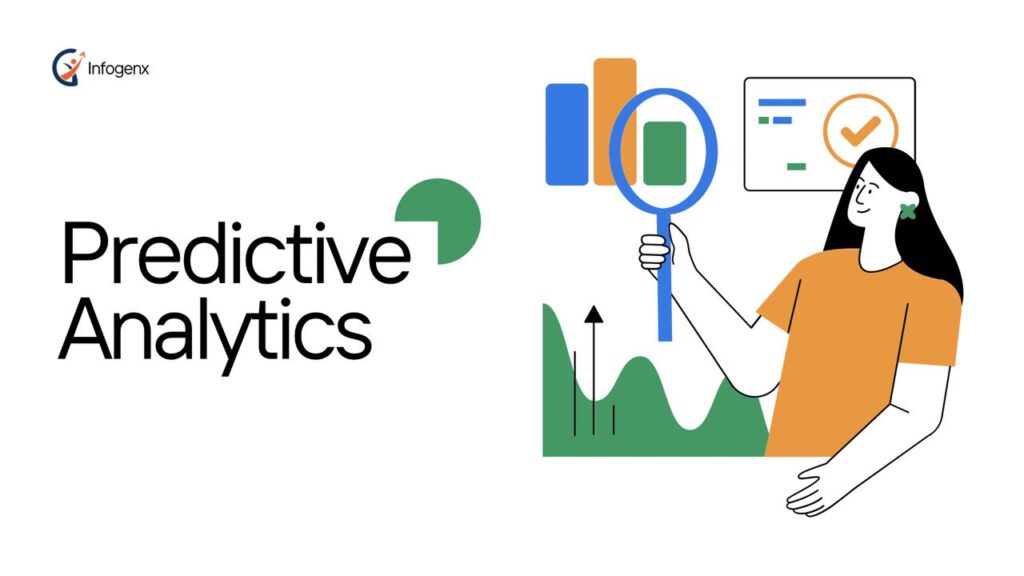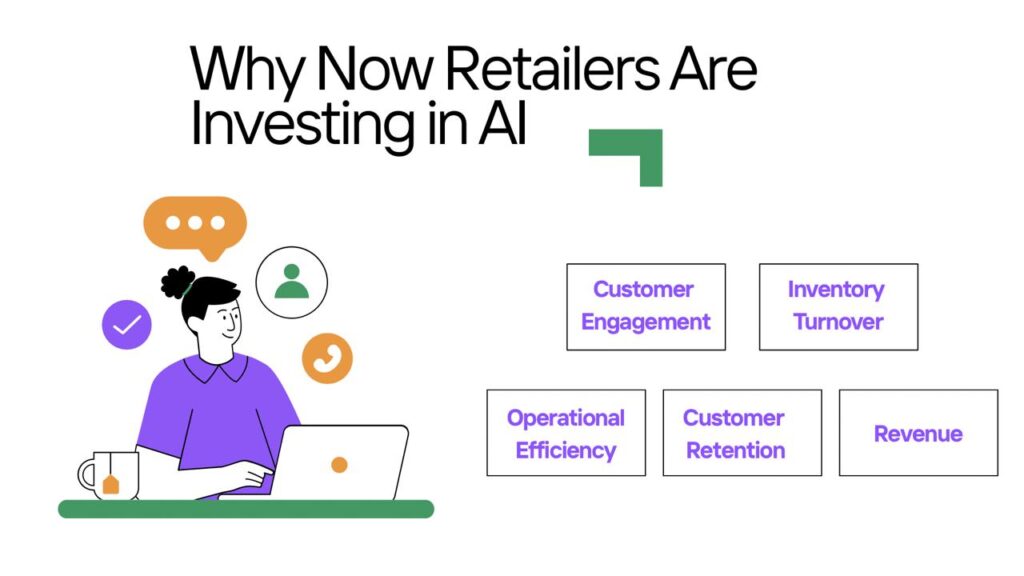
Introduction: The Age of Intelligent Retail
Retail is not as it used to be. Data-driven models are taking over the traditional stocking, pricing, and selling models that are smarter, faster, and more customer-oriented. The core of this change is Artificial Intelligence (AI) – namely predictive analytics.
The retailers of today need to do more than merely respond to consumer behavior. They should be able to expect it. The use of AI and machine learning in the form of predictive analytics is helping businesses make predictions, manage inventory, create personalised experiences, and increase profitability more than ever before.
Now, we will discuss how predictive analytics based on AI is transforming the retail sector, its major use cases and how organisations such as Infogenx can assist retailers in undergoing this transformation.
What is Predictive Analytics in Retail?
Predictive Analytics refers to the art of using data, statistical algorithms, and machine learning to determine the probability of an event occurring in the future as a result of past data. Predictive analytics assists businesses in retail to:
- Forecast Demand
- Expect Customer Behaviour
- Optimise Promotion and Prices
- Handle the Supply Chain Effectively
- Increase the Efficiency of Operations
Predictive analytics converts raw data into meaningful actions and therefore, makes gut-based decision-making a thing of the past.

Fact: McKinsey predicts AI-based forecasting is capable of cutting supply chain errors by as much as half and lost sales by as much as 65 per cent.
Check out how our Analytics and Artificial Intelligence (AI) solutions empower organizations to unlock actionable insights, drive intelligent automation, and make smarters, faster decisions.
Transformation of Retail with AI-Powered Predictive Analytics
And what is it in real life that is changing the face of retail? Let’s discuss:
1. Hyper-Personalised Customer Experiences
Retailers are currently applying AI to customise shopping experiences for every customer. Predictive models can analyse:
- Browsing Behaviour
- Past Purchases
- Page Times
- Abandoned Carts
This information drives smart product suggestions, custom email, and push notifications that drive conversions.
Example: Netflix-level personalisation can be applied in e-commerce nowadays, with the AI suggesting items to the user even before she/he search.
🔁 Personalised communication may increase conversions by 20 per cent and make customers buy again.
2. Demand Forecasting and Inventory Optimisation
Demand forecasting can be listed among the strongest use cases of predictive analytics. AI is able to forecast trends in seasons, regional purchase trends and even local weather effects to guide stock levels.
- Limit Overstock and Understock
- Optimize Warehousing
- Standardise the Application Chain Strategies
Example: A clothing merchandise store can utilise AI to predict that sales of denim will increase in September and can plan and incorporate production and supply chain to manage the situation.
📉 The cost of carrying inventory is minimised by up to 30% by predictive inventory systems.
3. Promotion Optimisation and Dynamic Pricing
Static pricing models are just ineffective in a competitive market that runs at a fast pace. Predictive Analytics assists the retailer to dynamically change prices in real time depending on:
- Market Demand
- Competitor Pricing
- Customer Behaviour
- Product Availability
The use of AI determines the most appropriate time and audience to conduct the promotion to maximise ROI on discounts without damage to the margins.
Example: Airlines and ride-hailing applications are based on dynamic pricing models- now retailers can also use them.
4. Stopping Churning of Customers and Prediction
It is costly to lose loyal customers. Predictive analytics forecasts churn and thus predicts when they are likely to occur and instigates active retention programs before it is too late.
- Mail loyalty offers
- Start customised check-ins
- Provide special offers
Use case: A VIP customer who is at risk of churning will get a tailored discount or email, and re-engage him or her.
💡A 5 per cent decrease in churn leads to a 25-95 per cent increase in profits.
5. Workforce Optimisation and Store Operations
Artificial intelligence does not only apply in e-commerce. Rick-and-mortar stores can also utilise:
- Heatmaps of Foot Traffic
- The best staffing schedules
- Monitoring the customer behaviour in-store
- Queuing of self-checkouts
Predictive tools provide the retailer with an efficient way of allocating human resources, preventing understaffing, and improving the in-store experience.
6. Risk Mitigation in the Supply chain
Some of the early warning signs of the supply chain disruption that retailers can use AI to identify include:
- Vendor delays
- Transportation bottlenecks
- The activities of the world (e.g., pandemic, wars, and inflation increase)
Predictive analytics provides real-time alerts as well as backup planning strategies to reduce the risk and downtime.
Check out how our Cloud Computing services help organizations unlock the full power of digital transformation with scalable architectures, AI integrations, seamless automation, and future-ready security.
The Business Case of Why Now Retailers Are Investing in AI:

Predictive Analytics with the help of AI is not a trend, it is a competitive necessity. Retailers using such tools are experiencing quantifiable results on all fronts:
| Impact Area | Result |
| Customer Engagement | Twenty five percent growth in personalised sales |
| Inventory Turnover | A decrease in excess stock of 30 per cent |
| Operational Efficiency | +40 % increase in forecast accuracy |
| Customer Retention | Reduction of churn rates by -20 percent |
| Revenue | ROI of up to 2x on predictive marketing campaigns |
Learn how you can shift your Business To The Cloud for maximum benefits!
The Way Infogenx Can Assist Retailers to Win Using Predictive Analytics:

At Infogenx we are experts in the development of intelligent, scalable, and cloud-native AI solutions which transform retail businesses.
We have services such as:
- Retail Teams No-Code Dashboards
- POSIE-CRM Systems integration
- Demand and Sales Forecasting Models
- Customer Journey Mapping Tools
- Dynamic Pricing Engines
We implement the best-in-industry development tools such as Power BI, AWS, Azure, Snowflake, Databricks, Python, etc, which allows the smooth integration and rapid deployment.
At any size of retailer and any point on your growth curve, we enable you to shift to predictive retailing, with no disruption to your business.
Are you Ready to Transform the Power of Predictive Retail?
We can transform your retail information into wiser decisions and better results.
👉 Book your free consultation today
Future Trends in Predictive Retail
In the future, AI in the retailing industry will be more than predictive to prescriptive and cognitive insights:
- Prescriptive Analytics will recommend specific courses of actions (e.g. price this product at 499 rupees today)
- In store tracking and theft prevention with Computer Vision
- 24/7 customer care Voice & Chat AI
- Real time processing in store, without cloud latency using Edge AI
Early adopting retailers will take the advantage of this new wave of innovation.
To know more, check our Applications of Generative AI, Trends, and Predictions for 2025!
Final Thoughts:Retail is the Superpower of Predictive Analytics
In the era of increasing customer demands and shrinking margins, data is your most significant source of power, and AI is what brings it to the fore.
Through predictive analytics, retailers become clear, controlled, and competitive. At Infogenx, we enable you with smart, scalable and customized solutions.
🔍 FAQs
The concept of predictive analytics in retail is, based on historical sales data and customer behavior patterns, as well as machine learning models, predictive analytics in retail is calculated to predict future trends. It assists the retailers in informed inventory, marketing, pricing, and customer engagement decisions.
All these applications of AI set the customer experience to a new level, including recommendations of the most hyper-personalized products, optimization of search results, personalization of marketing campaigns, and chatbots as the instant source of support. It predicts customer demands and assists retailers in satisfying them in the real time.
Yes, the use of predictive analytics will largely help cut inventory costs because demand can be predicted. It will avoid overstocking, will reduce deadstock and will enable retailers to manage their stocks efficiently in different locations.
No, online retailers and offline retailers can benefit. Whereas e-commerce networks apply it to personalisation and planning of demands, stores apply it towards prediction of foot traffic, workforce scheduling and optimisation of product placement in stores.
Infogenx offers an end-to-end predictive analytics solution- including data integration and dashboard development as well as deployment of AI models. We personalize our services to your retail objectives, be it increasing sales, churn reduction, or performance of the supply chain.
👉 Request a free consultation to find out what your business can achieve.

